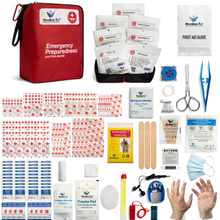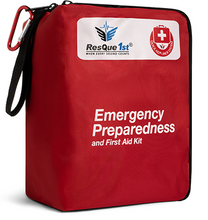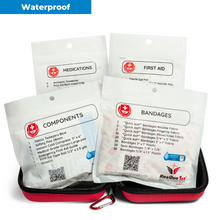
We talk a lot about items you need for a first aid kit, but what about the items you could do without? Knowing what not to include in your first aid kit keeps unnecessary items from taking up precious space. It also saves you from spending money on items you just don't need. Here's our list of the top 6 things you don't need to keep in your first aid kit.
6 Things You Don't Need in Your First Aid Kit
- Overly Specialized Items: If you're creating a kit for everyday situations (such as for your home or car), there's no need to invest in a mountain of overly specialized items. Most home mishaps can be addressed with bandaids, stretch bandages, or a dose of antihistamine. Piling your container with splints, thermal blankets, and snake bite kits loads you down with stuff you just don't need.
- Irrelevant Gadgets: First aid kits for the home or office don't need many gadgets. A pair of scissors, a pair of tweezers, a thermometer, and a first aid guide are about all you need. Resist the temptation to stock up on survival gadgets. Knives and multitools may come in useful if you're hiking in the backcountry, but they're generally irrelevant in everyday life.
- Ipecac: Some premade kits and first aid checklists include ipecac. Ipecac used to be recommended as a way to induce vomiting after poison is ingested. Today, this strategy is considered outdated. Get rid of any ipecac you have in your current kit. If you're building a kit from scratch, don't bother adding it.
- Too Much Medication: Pain relievers, antihistamines, and medications for stomach issues are all wonderful things to add to a first aid kit. However, you can have too much of a good thing. All medications have a shelf life, and if they're left in your kit for too long they may lose their effectiveness. Don't overstock your kit with more medication than you know you'll use.
- Overly Complicated Items: Unless you're a trained first responder, it's likely that an emergency situation will cause you some stress. No one is at their best when stressed out, so do yourself a favor by keeping your first aid items easy to use. Don't include anything that requires special training to properly apply. Instead, focus in on items that are simple to open and use correctly.
- Inappropriate Items for Your Situation: It's worthwhile to put some thought into how and why you'll be using your first aid kit. Items that could save your life while hiking could be completely irrelevant if you're using your kit at home. Government regulations may dictate what you can and can't include in a kit for a workplace. Don't bother with items that aren't appropriate for what you're trying to do.









